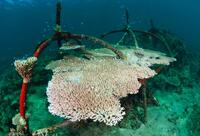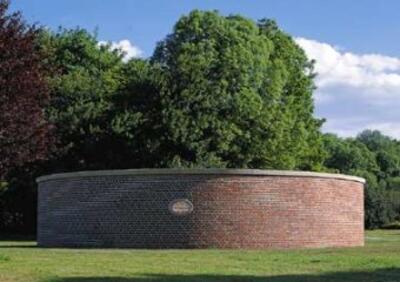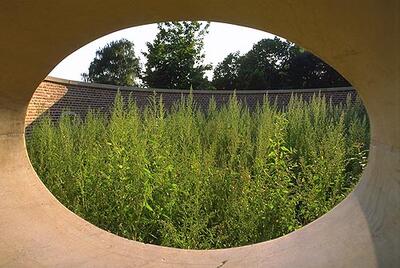Joseph Beuys: I wish to go more and more outside to be among the problems of nature and problems of human beings in their working places. This will be a regenerative activity; it will be a therapy for all of the problems we are standing before…. I wished to go completely outside and to make a symbolic start for my enterprise of regenerating the life of humankind within the body of society and to prepare a positive future in this context.
I think the tree is an element of regeneration which in itself is a concept of time. The oak is especially so because it is a slowly growing tree with a kind of really solid heartwood. It has always been a form of sculpture, a symbol for this planet.
Joseph Beuys, in: Richard Demarco, “Conversations with Artists”, Studio International 195, No 996 September 1982, p.46
Herman de Vries's sanctuarium, in Münster (northern Germany) in 1997, is a perfectly circular brick wall with no entrance to the inner sanctum, which is visible through four oval oculi, piercing the wall at eye-level at the cardinal points, the directions of the winds. Terrain vague is the future of cities; new worlds of experience, which guide our consciousness to a different order, away from the chaos of planning. the terrains vagues are the avant-garde of nature [cited in herman de vries, 'terrain vague (1999)', in exhibition catalogue No art - no city! Stadtutopien in der zeitgenössischen kunst = No art - no city! Urban utopias in contemporary art (Ostfildern 2003) 156-157]
saint_francis had very unusual gardening advice. He thought there should be no ditches or fences around a garden, because this denotes private ownership. There should be nothing to mark the difference between the garden and surroundings. People, animals and plants were free to pass through the garden.
- The Garden of Saint Francis; plants, landscape and economy in 13-th century Italy more
The Mangrove Ring. Robert Smithson's only realised work involving living plants, his interest in the elemant earth was his motivation of the use of living vegetation. Simthson was fascinated with the long term “land-making” effect of the mangrove, a tree with submerged roots which flourishes along the coast of Florida. The Mangrove Ring was made by planting seedlings in 1971 into sediment deposits in cracks in the rocky bottom of the lagoon in Florida. Magrove seedlings are suppossed to take root almost immediately. There is a story that Alexander de Great stopped his March through Asia to observe mangroves making land. mangroves called “island Makers” because they catch sediment in their spidery roots.“
from:”… The Earth, Subject to Catalysmus, is a Cruel Master', in Robert Smithson: The collected writings, ed. Jack Flam, Berkeley andd Los Amgeles, 1996. p. 261

To build a Biorock reef, (developed by Thomas Goreau and Wolf Hilbertz in the 1970's) a low voltage electrical current is passed through a conductive frame (metal meshes) that’s anchored to the seabed. Power can be sourced from chargers, windmills, solar panels or tidal current generators. The electrolytic reaction causes mineral crystals such as calcium carbonate and magnesium hydroxide found in seawater to grow on the structure. Within days, a whitish hue that is made up of precipitated minerals coat the structure’s surface – a sign that the wired frame is ready for action. Divers then begin transplanting coral fragments from other reefs and attach them to the frame. The coral pieces begin to bond to the accreted mineral substrate immediately and start to grow at a rate up to five times faster than usual. Soon the frame with dotted corals becomes a habitat for a reef ecosystem, attracting colonizing marine life such as fish, crabs, clams, octopus, lobster, and sea urchin.
To build a Biorock reef, (developed by Thomas Goreau and Wolf Hilbertz in the 1970's) a low voltage electrical current is passed through a conductive frame (metal meshes) that’s anchored to the seabed. Power can be sourced from chargers, windmills, solar panels or tidal current generators. The electrolytic reaction causes mineral crystals such as calcium carbonate and magnesium hydroxide found in seawater to grow on the structure. Within days, a whitish hue that is made up of precipitated minerals coat the structure’s surface – a sign that the wired frame is ready for action. Divers then begin transplanting coral fragments from other reefs and attach them to the frame. The coral pieces begin to bond to the accreted mineral substrate immediately and start to grow at a rate up to five times faster than usual. Soon the frame with dotted corals becomes a habitat for a reef ecosystem, attracting colonizing marine life such as fish, crabs, clams, octopus, lobster, and sea urchin.
source: http://matthewoldfield.photoshelter.com/
see also category gardens



